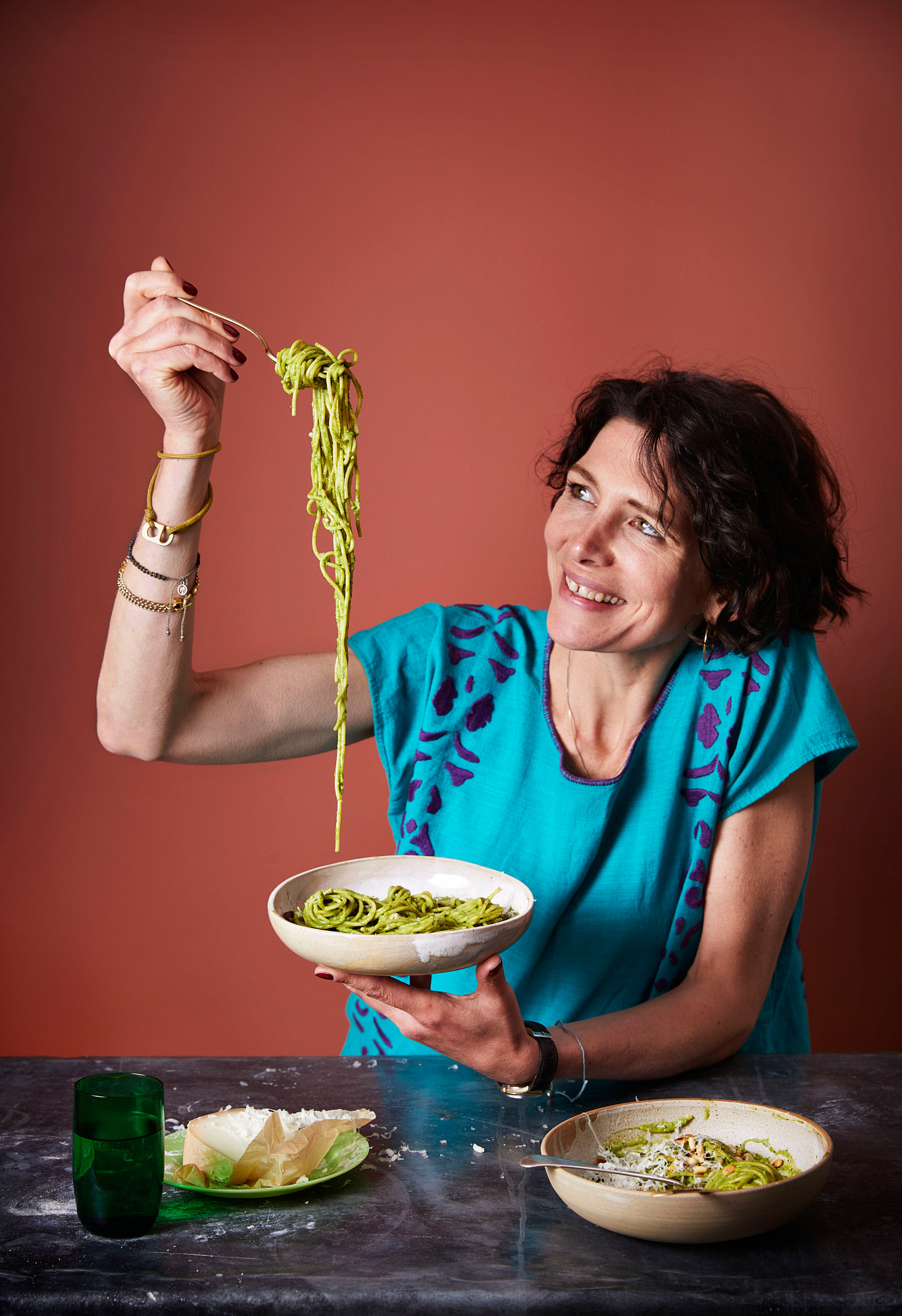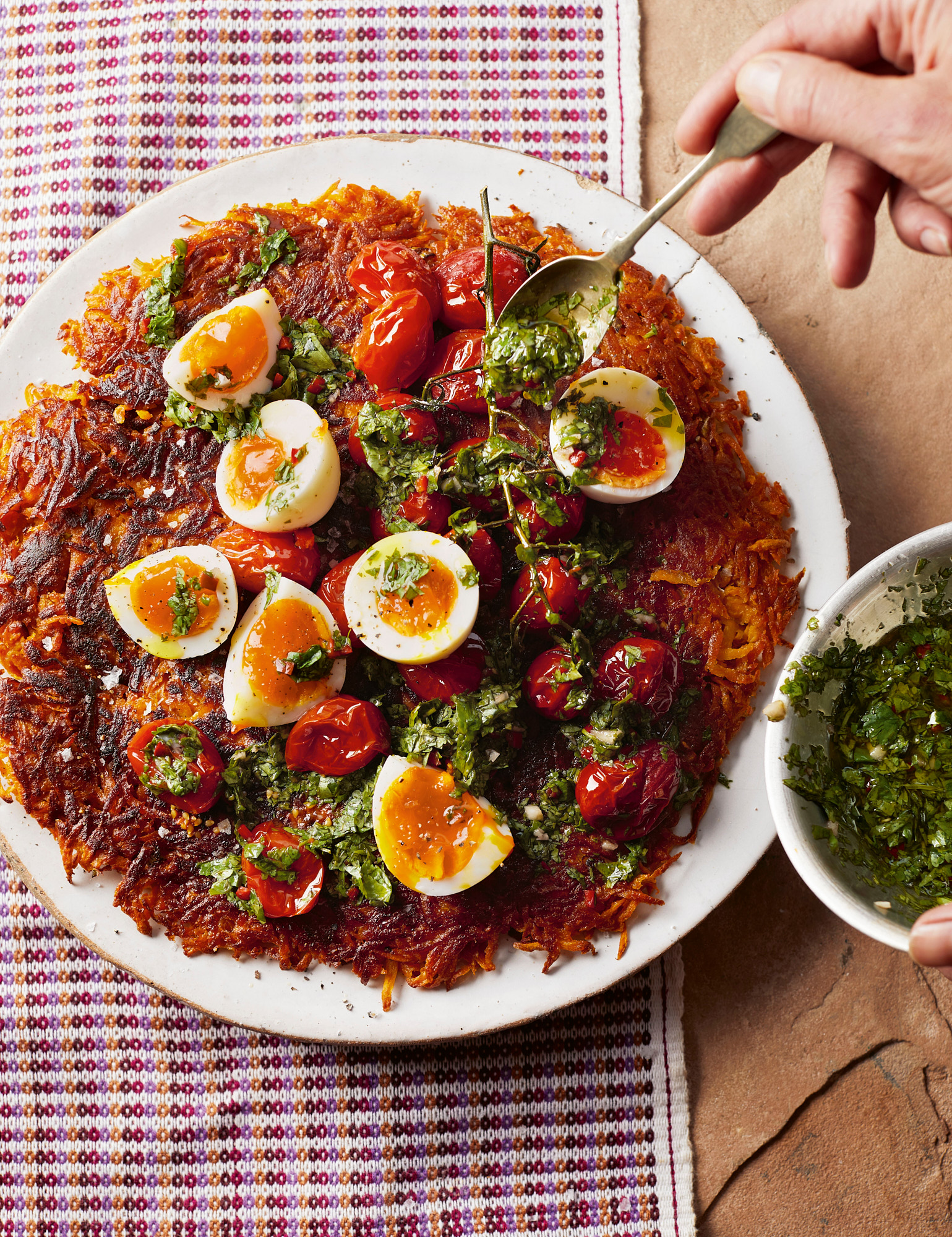
Eat For The Planet: At The Table with Thomasina Miers

Tommi Miers is a fierce advocate of eating for the planet. Since winning Masterchef and founding Wahaca back in 2007, she has paid homage to the vegetable rich Mexican diet using seasonal British ingredients, with a strong focus on eating good quality, sustainably sourced produce. Through her work with Soil Association and Chefs in Schools she highlights the need for everyone to have access to good quality ingredients and an understanding of how our food is grown, and she has a lot of fun doing it. We sat down with Tommi to chat about her food philosophy, how the Mexican diet inspired her work and how thinking about the impact of food on our soils is part of celebrating the sheer joy of cooking.
Tommi, tell us a little bit about yourself — where did your journey in food and cooking begin?
I grew up loving to cook. I used to sit at a stool by my mother’s side and watch her make magic in the kitchen. She used to do amazing things with simple ingredients, slow cooking onions until they were soft and sweet, making mayonnaises at the drop of a hat, browning flour in butter until nutty and delicious before making a white sauce. She taught me the fundamentals of cooking which have served me ever since. Growing up I would ask if I could cook dinner and the game was to open the fridge and see if I could conjure something up with what ingredients she had bought on her weekly shop.
“We know we need to eat less meat if we are to curb carbon emissions; we know that we need to eat a greater diversity of vegetables for optimum gut health; embracing a diet rich in vegetables, even if you are going to eat meat occasionally feels like a wonderfully positive step.”
Because she was counting her pennies she shopped in tune with the seasons so whole globe artichokes with beurre noir and fresh bread for dinner in the summer, or oxtail soup with root vegetables in the winter. We ate incredibly well, but with very simple, seasonal ingredients. Later on, when I was a teenager, cooking dinners for my parents’ friends provided much needed pocket money.


Your love of Mexico and its food comes across so strongly in your writing, your recipes, your restaurants — everything you do. What was it about the cuisine and history that resonated with you?
When I first went to Mexico and made my way through the through the valleys of Oaxaca, the uplands of Chiapas, the beaches of the Yucatan and the rainforests of Veracruz I was astounded by how delicious the street food was and how much it changed from region to region, village to village. I was amazed by the unexpected diversity of fruit and vegetables and how few of them I recognised. Much later, at a dinner held at Kew, I learnt that Mexico is mega-diverse with 50,000 native plant species from herbs, greens, corn, chillies, squash plants, fruits and edible flowers (the UK has about 1500 in contrast). So the food thrilled me but I was also fell in love with how food and cooking seemed woven through every inch of Mexico’s fabric, where everyone seemed to delight in talking at length about what their grandmothers used to cook and the food of their village or state; where every occasion and event is an excuse for feasting.
Why Mexico? What inspired you to go there, and what made you want to share your interpretation of Mexican food over here to the UK once you had experienced it?
I studied modern languages at school and it was my father who suggested travelling to the Americas, as he had worked out there over his career. I worked for an accountancy firm after school and with a nest egg they gave me I travelled to Mexico before the start of university. In those days most people, including me, thought that TexMex was Mexican food. On that first trip I discovered a whole different story. When I came back to the UK, determined to eat more Mexican, I soon discovered there was none to be found. I couldn’t believe that a country with such a rich culinary heritage, with such delicious food, was completely unknown in the UK. Ten years later I went back and lived in Mexico for a year to learn more about the food and when I came back I couldn’t shake the feeling that I should set the world to rights and put some decent Mexican food out there.


Your latest book Meat Free Mexican focuses on vegetarian and vegan Mexican-inspired dishes — they’re all so bold, colourful and fresh. Why did you feel now was the right time to focus on a meat-free theme? Does it reflect your wider food philosophy and outlook on how we should be eating?
The ancient Mexican diet felt strikingly similar to many vegetarian and flexitarian diets being embraced around the world. Yes the Mixtecs and Aztecs would fish and hunt when they could, and used insects and ground nuts to bump up their protein intake, but the main diet was a celebration of vegetables and fruits, full of beans, corn, chillies, tomatoes, squashes and many other vegetables besides, which together provided them with all the nutrition they needed for a healthy, complex diet. We know we need to eat less meat if we are to curb carbon emissions; we know that we need to eat a greater diversity of vegetables for optimum gut health; embracing a diet rich in vegetables, even if you are going to eat meat occasionally feels like a wonderfully positive step. Lockdown happened and it was the perfect moment to create a book full of Mexican-inspired recipes that put fruit and vegetables at centre stage.
You write in the book that Mexico has 50,000 different native plant species — herbs, greens, corn, chillies, squash plants, fruits, edible flowers — in comparison to 2,000 in Britain! How do you navigate recreating Mexican flavours here in the UK whilst keeping your local, seasonal food philosophy and using British ingredients?
I can’t get hold of many of the wild herbs, greens, fruits and chillies that are native to Mexico but by shopping at farmers’ markets and greengrocers (and a few Mexican specialists for the dried chillies) I can do a pretty good job. I grow or buy huge amounts of tarragon, oregano, coriander, parsley and thyme to recreate the flavours of Mexican herbs. I make chilli oils with dried chillies we can buy over here, and I buy delicious varieties of squashes and pumpkins, courgettes and tomatoes and even tomatillos which are now grown in this country. And I use Mexican cooking techniques and chillies to cook with seasonal, British produce. It is endlessly interesting and fun. Mexican food is incredibly popular in this country but I still feel that people are just discovering its amazing diversity and total deliciousness.
Talk to us about chillies. You mention in the book that there are over 200 types in Mexico! How can a chilli transform a dish? Do you have a favourite to cook with?
I tried to work with just a handful of chillies in the book so that people could buy a small range and experiment with how their different flavours could transform food. So ancho for its deep, rounded sweetness; cascabel for its fruity, rich mild flavour; guajillo another mild one, which stains food a beautiful brick red; arbol for that dry grassy heat (like a sprinkling of dried chilli flakes); chipotle for smoky fire. With those five you can do many exciting things to everyday ingredients and none of them need to be so spicy that they blow your head off – I prefer subtle heat and delicious, nuanced flavours.


In 2016, Wahaca became the first restaurant group in the UK to receive carbon neutral status, which is a huge achievement. Whilst restaurants can lead the way, how can we as consumers make sure we are thinking more consciously about our food and having a positive impact whether we’re cooking at home or dining out?
We all have so much power to impact our food systems which are responsible for 30% of greenhouse gas emissions, we just need to believe in our own power and have agency over the food we eat. Conventionally grown crops are sprayed with herbicides and pesticides that are killing our soils and the insect populations on whom we rely for our own survival (the earthworm and the bumble bee for a start), plus they are linked to so many cancers and other illnesses. We have to start putting pressure on our government to ban herbicides and insecticides and support regenerative farming systems. And if we care about the planet we need to avoid factory farmed meat – meat was always eaten for special occasions when my grandparents were alive – we need to get back to buying better quality meat but eating it far less and really investing in eating a wide range of vegetables and cooking them in delicious and interesting ways. Supporting farmers’ markets and buying locally is also a brilliant way to choose what farming system your money goes to support.
If you were to to take us on a trip to Mexico, where would we go, what would be on your list to visit and what would we eat?
There are so many wonderful regions to Mexico, I could write a book on where to go and what to visit but my favourite states are Baja California for the amazing vineyards and biodynamic farms (not to mention the seafood); Veracruz for the seafood and landscape; the Yucatan for the recado negro and the amazing haciendas, and of course Oaxaca for the wonderful food. Mexico is a delight and we are still only just realising how extraordinary its food is.
Tommi’s Pantry
(5 items that are always in your pantry, or that you can’t live without!)
1. A small range of dried chillies to use in so many different ways including guajillo (mild), chipotle (smoky), arbol (hot), ancho (sweet and rounded) or cascabel (mild and fruity)
2. Extra virgin olive oil for drizzling and dressings – I get through so much – great for good gut health and fantastically delicious
3. Sea salt – we need it for our survival. Seasoning makes food taste great.
4. Herbs in pots. Grow as many as you can and put them in your windowsills – they are so much more abundant when grown in pots, and so much cheaper to use abundantly in your cooking.
5. My red wine vinegar mother – throw in the ends of good bottles of wine and use a first rate vinegar to add much needed bursts of acidity to your cooking (lemons and limes also useful here!)
Read more: Cook Thomasina’s Recipes
Click to cook Thomasina’s recipes from her latest cookbook Meat-Free Mexican, on Another Pantry. Think summer courgettes with whipped feta, stuffed poblano peppers and a zingy burrata & tomatillo salad.





